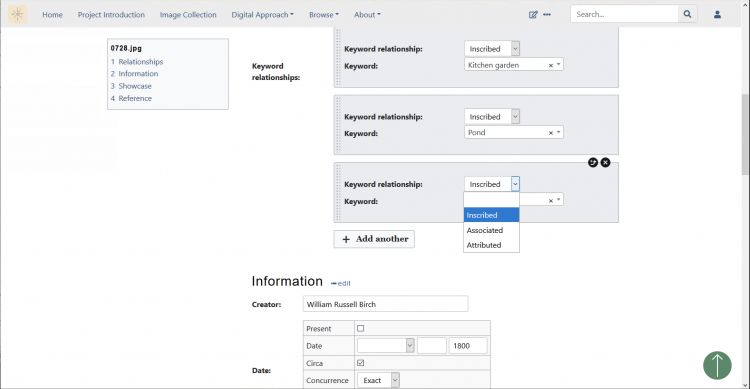Semantic HEALD
In spring and summer 2021, HEALD underwent a substantial upgrade that has partially changed the appearance of the site while significantly modifying how it operates while boosting its potentialities.
An important phase of the upgrading process was the enabling of the Semantic Web, which has increased the potential to query and extract data from the site. Even though Semantic MediaWiki is among the functionalities embedded in the software, it was not originally utilized. An extension called Page Forms [Fig. 1] was added to the site to assign controlled values to data, such as “Role”; “Reference Title,” “Medium,” “Dates,” and so forth. Page Forms extension was added to the following pages: Image files, People, and Places. Once these pages are completed with the addition of metadata, the RDF export button can be used to export and download the data (read more about RDF format here).
On the image file page, Page Forms is used to display a comprehensive exportable table that includes information about the relationship of the image with one ore more of the keywords. Such relationship is expressed as inscribed, associated or attributed (see the User's Guide). These details, along with information about creator, medium, and repository, are collectible via the RDF export. On each People and Place page, a similar process is dedicated to the Overview section at the top of the page, also exportable. The implementation of the Semantic Web for image files allowed the creation of the Image Collection section, which is described in the User's Guide page.
The Semantic Web was implemented through Semantic MediaWiki to enhance the sustainability and longevity of the site by making the data exportable and therefore retrievable (read more about our Digital Approach). Full implementation of the Image collection is in process through Page Forms. We hope it can serve as a model for projects similar to HEALD, that make use of extensive descriptive text with bibliographical references, interrelated image files, and a network of interlinked categories (in this case, Keywords, Images, People and Places). The custom code for the Page Forms extension is available on Github as open-source software for developers to fork (copy) and re-use. The extracted data will offer opportunities to compare and contrast HEALD content with available data coming from similar projects in the field of the history of landscape design, or in the broader field of cultural history.
